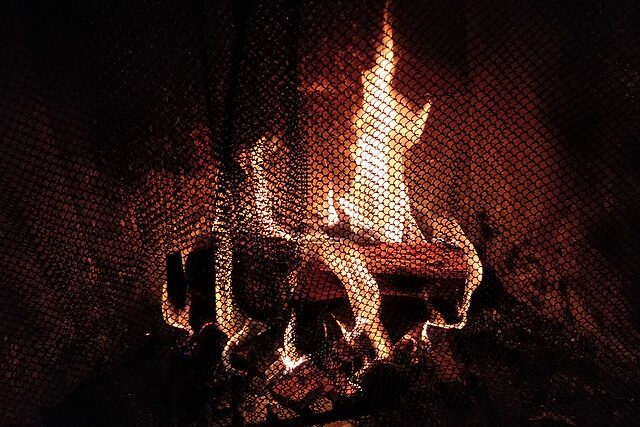
As winter descends, the streets near my house become a scene of bustling activity as lorries deliver logs for heating. Local DIY shops and garages are stocked with wood and smokeless fuels, and once again, the familiar aroma of smoke fills the air in my neighbourhood.
While a crackling fire may evoke feelings of coziness, it is not without a broader cost, as highlighted in the previous year’s chief medical officer’s report, which identified solid fuels as the most polluting method of home heating.
A comprehensive study conducted by Ricardo Energy and Environment reveals alarming consequences of outdoor air pollution from solid fuel heating in London. The study estimates that 284 Londoners face premature death each year due to this pollution, accompanied by approximately 90 new cases of childhood asthma, 60 cases of stroke, and 30 cases of lung cancer annually.
The associated health and economic costs reach a staggering £187 million annually, equating to £24 per Londoner, irrespective of whether they utilise solid fuels or not. From a polluter-should-pay perspective, each person in London employing a fireplace or stove imposes an average burden of nearly £800 annually.
This situation in London mirrors a broader European perspective, with a societal-health cost estimate of €760 (£650) per household annually for those using wood stoves.
Prof Fay Johnston, from the Menzies Institute for Medical Research, Tasmania, who was not involved in the London research said: “Given the high health and economic burden of pollution from this type of heating, interventions to reduce wood heaters in densely populated areas will be highly cost effective. Even small reductions in outdoor wood smoke will reduce the community burden of chronic heart and lung diseases, and increase the average life expectancy of people living in London.”
According to UK government figures, the domestic use of solid fuels stands as the second-largest contributor to airborne particle pollution in the country. Although some burning occurs outdoors, particularly during patio heating in the summer, the bulk of solid fuel pollution is measured during winter evenings when households actively heat their homes.
The issue extends beyond metropolitan areas, as evidenced by efforts in Chorley, Lancashire, where Mark Tebbutt and collaborators have installed measurement equipment across the town. Their data exposes frequent violations of World Health Organisation guidelines and sheds light on the burning habits of residents.
Tebbutt explained: “Chorley has a high number of older terrace houses with fireplaces and the smell of burning often wafts through my home. Solid fuel burning mainly takes place during the weekend evenings, Fridays to Sundays, from October to April but has increased in the cost-of-living crisis.”
The recent study is part of the London Wood Burning Project, funded by Defra, with the participation of 18 councils. Scientists from Imperial College London deployed measurement equipment in the homes and gardens of solid fuel users. Additionally, researchers covered approximately 125 miles (200km) of streets, carrying backpacks laden with sensors.
The primary indoor exposure to particle pollution occurred during the ignition of fires or the addition of fuel, although this was often less than indoor pollution from cigarette smoking or cooking. Furthermore, the researchers identified particle pollution immediately outside homes using solid fuel, including those with the most modern stove types.
The study identified persistent wood burning hotspots in residential streets, aligning with national surveys reporting complaints from individuals whose homes are affected by neighbours’ fires. As winter settles in, the charm of a crackling fire is overshadowed by the substantial health and economic burdens imposed by solid fuel heating practices.
John Casey from Imperial College London, who led the fieldwork investigation, said: “In the end our noses proved a pretty good detector for wood and coal burning. We couldn’t see individual chimneys or smoke in the dark but as we walked the streets solid fuel burning smells would suddenly become obvious. We noted these locations for each walk. When we later analysed measurement data from the backpacks we found that our smell map matched our data quite well. If you’re smelling solid fuel burning then you’re likely being exposed to extra particle pollution.”
——————————————————————————
At Natural World Fund, we are passionate about stopping the decline in our wildlife.
The decline in our wildlife is shocking and frightening. Without much more support, many of the animals we know and love will continue in their decline towards extinction.
When you help to restore a patch of degraded land through rewilding to forests, meadows, or wetlands, you have a massive impact on the biodiversity at a local level. You give animals a home and food that they otherwise would not have had, and it has a positive snowball effect on the food chain.
We are convinced that this is much better for the UK than growing lots of fast-growing coniferous trees, solely to remove carbon, that don’t actually help our animals to thrive.
This is why we stand for restoring nature in the UK through responsible rewilding. For us, it is the right thing to do. Let’s do what’s right for nature!
Donate today at https://naturalworldfund.com/ and join in the solution!

